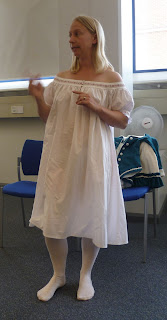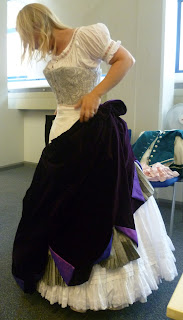A
few weeks ago I had the pleasure of watching historical costume expert,
Mireille Weller, demonstrate what a Victorian lady in 1875 would have worn,
from the shift up. As I watched her getting dressed, I realized that it was not
that different from Regency times, so I thought a post on 19th century underwear might be
interesting.
The
defeat of Napoleon at Waterloo signalled not just a change in the map of Europe,
but also a change in fashion. After twenty-five years of war, people were
desperate for something new. As the waist slowly descended to normal levels,
the base of the skirt, held in place by a wadded hem, began to bell out. Stays
had always been worn but now they became stiffened with whale bone and
extra-tight lacing came in to emphasize the waist. By 1818, fashion dictated
that a small bustle (known colloquially as a ‘bum-roll’) be tied as high up as
possible under the back of the skirt to create the fashionable ‘Grecian bend’. In
fact, according to The Handbook of
English Costume in the 19th Century, a miniature version of this
was in evidence even earlier before 1810.
And,
we must not forget that the formal dress of the 18th century, with huge
hooped skirts for the ladies, was the correct court wear until 1820. Our
heroines would have had to cope with hoops and corsets, if they were to be
presented to the Queen. So how did they manage?
Stage 1: the shift and stockings
Mireille,
our guide, appeared in her shift and stockings. Her shift was a loose cotton
(linen in the Regency) garment with short sleeves and a scooped neckline which
fell to just below the knee. It was ubiquitous throughout the 19th
century, being cheap and easily washable. Her cotton stockings were held up by
garters above the knee. Our Regency heroine’s stockings were held up by garters
below the knee and, thus,
occasionally visible.
This
could lead to some embarrassment as the following poem from The Oracle of 1800 shows:
Why blush, dear girl,
pray tell me why?
You need not, I can
prove it;
For tho’ your garter
met my eye
My thoughts were far
above it.
Stage 2: the open-crotch drawers
Mireille
then put on her open-crotch drawers, tying the strings at the back. Then she
pulled the shift out so that only the legs of the drawers showed.
Stage 3: boots
So,
what came next? The answer was unexpected. Boots. Mireille had learnt from
experience that once she’d got her corset on, it was impossible to bend down
enough to put on her boots, so they had to come first.
Stage 4: the corset. This was fastened at the front and tightened at the back.
Then
came the hooped petticoat plus the bustle at the back to give the right silhouette.
And our Regency heroine would have attached the bum roll at this point.
Stage 5: the crinoline and bustle
Next
came the corset. This fastened at the front with wire hooks and eyelets but
there was also lacing at the back which Mireille could tighten herself. She
invited me to measure her waist before and after. Her waist was one and a half
inches smaller after she’d tightened the laces and, doubtless, a determined
maid could have lost another inch or so.
Interestingly,
tightly-laced stays were worn throughout the early Regency period. As The Ipswich Journal put it in 1807: ‘long stays are adapted to give the wearer
the true Grecian form’. And in 1813, a garment described as an ‘Apollo’
was, according to The British Press, ‘a sort of under-dress or coat of mail worn by
ladies to make their waists looks slender and genteel.’ It sounds
excessively uncomfortable!
Stage 6: the first petticoat goes on over the head.
Next
came the petticoats – two of them. She put them on over her head as she
couldn’t bend enough to step into them. The second petticoat was more decorated
than the first and they were both there to hide any evidence of the crinoline
or bum roll ‘scaffolding’. In winter, a Victorian lady would have also worn a
scarlet flannel petticoat for warmth. Since Medieval times, the colour scarlet
was thought of as being, literally, warming; the early 17th century
portrait of the Cholmondeley sisters in the Tate Britain gallery, each holding
a baby swaddled in scarlet, is a good example. And we know that ‘The Princes of Wales wore a very large red
shawl at the theatre’ in 1808. Presumably this, too, was for warmth.
Stage 7: the second, more decorated petticoat
Of
course, having two or more petticoats, each one more elaborately decorated than
the one underneath, allowed a lady to lift her skirt a fraction to display a
froth of lace.
Stage 8: the skirt
Then
came the skirt which also had to go on over the head – and you can see from the
photograph how awkward it was to arrange properly. In reality, Mireille would
probably have had a maid to help her. The skirt fastened at the back.
Stage 9: the decorative over skirt
After
that, she put on the overskirt. This was purely decorative.
Stage 10: the bodice
Lastly,
Mireille eased herself into her bodice and showed us the false curls which
would enable her to put up her hair in a fashionable chignon with ringlets
hanging down. The hair-style is not too dissimilar to the antique Roman style
fashionable in 1812. Plus ça change…
You
can see that with so many separate garments, even the simple act of sitting
down could be a problem. This was why, Mireille explained, a gentleman pulled
out a lady’s chair in the dining-room. His job was to give her the space to
manoeuvre all her petticoats, crinoline and skirt into position so that she
could sit down; and for that she needed both hands. The gentleman then gently
pushed the chair forward so that she could sit safely – without, we hope, landing
her on the floor.
It
was a fascinating demonstration and Mireille’s explanations were equally
interesting. All the same, I found myself thinking: thank goodness I live in the
21st century.
All photographs by
Elizabeth Hawksley
Elizabeth
Hawksley
 One of my favourites is Lyme Park , on the border of Cheshire and Derbyshire. Lyme Park is one of the most famous, and beautiful, houses in England. It's probably most well known for its appearance as Pemberley in the 1995 BBC mini-series of Pride and Prejudice. It's immediately recognisable because of the mirror lake in front of the house, which, on a clear day, perfectly reflects the house. Nowadays, visitors approach the house from the other side but in its heyday, the drive led up to the side by the lake.
One of my favourites is Lyme Park , on the border of Cheshire and Derbyshire. Lyme Park is one of the most famous, and beautiful, houses in England. It's probably most well known for its appearance as Pemberley in the 1995 BBC mini-series of Pride and Prejudice. It's immediately recognisable because of the mirror lake in front of the house, which, on a clear day, perfectly reflects the house. Nowadays, visitors approach the house from the other side but in its heyday, the drive led up to the side by the lake.



























